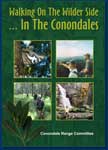Launch Review
11.07.04
It was a tent-overfilling crowd of around 150 that gathered at Fairhill Native Plants for the launch of our book ‘Walking On The Wilder Side… in the Conondales’ and our website www.exploreconondales.com.
The colourful and informative book represented an enormous upgrade from a previous low-budget booklet of walks in the Conondale region produced by Cheryl Seabrook some years ago. Although the Conondales are a key conservation area in southeast Queensland, they have generally featured only as small sub-sections in other books.
‘Walking On The Wilder Side’ is devoted almost entirely to the Conondales, but also adds nearby walks at Gheerulla as well as the Great Walk on the Blackall Range.
More than just walks though, it is very special in including sections by a number of writers with special biological and historical expertise in the Conondales. It features the conservation history of the Conondales; how this great forest mosaic, once destined for clear-felling for hoop pine plantations, has slowly and incrementally been either added to the National Park estate or been afforded other protective tenure.
Conondale Range Committee President Ian Mackay acted as MC for the launch and welcomed guest speakers Carolyn Male [Member for Glasshouse], Richard Giles [past Project Officer for the CRC] and Mark Ricketts [long serving CRC Vice President].
All spoke of their love of, and involvement in, the Conondales, and Mark in particular, spoke of the dilemma in producing a book that would inevitably bring more people to the area. Through all our submissions over the years has been recognition of people’s needs to visit native forests, literally for ‘re-creating’. As Bob Brown puts it, “people don’t put up photos of clear-felled forests or denuded hillsides, it seems we all have a need to be somewhat in-touch with a natural world, and for many this means visiting National Park or State Forest areas. This isn’t something driven by groups like the Conondale Range Committee but in reality, this need has probably resulted in most of our wide support base over so many years.
We felt it was our special job to inform and educate visitors, a feature that is making eco-tourism the popular success that it is. We sought to inform them, not only of the forests and some of the special things that live there, but also of the protracted battle to see the area protected, firstly from rapacious clearing for farmland, then from plantation establishment and more recently from the ravages of gold mining.
A project such as this requires sustained enthusiasm and skills. Ours came from a couple of quarters. It was to Elaine Green that we owe the initial concept and hard work in securing funding from Queensland State Development and to Cheryl Seabrook that we owe the unenviable task of the myriad of functions entailed in bringing such a task to fruition.
The website, produced by a life-long visitor to the Conondales Arkin Mackay, is a ready and attractive way to access information and particularly photographs about the Conondales, purchase books and t-shirts, and generally keep up with the activities of the CRC. It will continue to grow as issues change. Do visit it at www.exploreconondales.com.
The Conondale Range Committee is indebted to the Queensland Government for funding towards this book and website. While we were able to supply the willing expertise in writing, researching, trialling walks and drives, and in collating, the assistance through funding has been the enabling factor.
Review by Ian Mackay
Launch photos by Birgit Kehr
BOOK REVIEW - Cooloola Advertiser 17.08.04
If you have never been to the Conondale Range west of Kenilworth, a new book about this significant natural forest is sure to spike your interest.
Walking on the wilder side... in the Conondales is the result of a continued effort by the Conondale Range Committee to preserve this sanctuary for generations to come.
This group rescued the Conondales - a key conservation area in South-east Queensland - from the onslaught of bulldozers and chainsaws 30 years ago when massive hoop pine plantations were planned. Since then members have sought to inform and educate visitors to the area, adding to the success of eco-tourism which recognises that people often need to visit native forests to stay in touch with the natural world.
The colourful book and a new website dedicated to the Conondales were recently launched at Fairhill Native Plants to an appreciative crowd of 150 people.
www.exploreconondales.com provides photographs and information as well as links to other sites in the area, and will grow and evolve as issues change.
Through funding from the Queensland Government, the glossy book is an enormous upgrade from previous low-budget booklets outlining various walks in the range and produced some years ago.
This new publication is more than a list of those walks. It includes sections by a number of writers with special biological and historical expertise in the Conondales, who tell the story not only of the forest and the special creatures that live within its boundaries, but also of the protracted battle to see the area protected both from the early clearing for farmland and later from plantation establishment and the ravages of gold mining.
Projects such as this require sustained enthusiam and skills and Elaine Green is credited with developing the initial concept and sourcing the funding while Cheryl Seabrook saw the project through.
Long time president of the committee Ian Mackay, a biology teacher and popular performance poet, said members were faced with a dilemma in producing the book.
While alongside the website it presents a ready way to access information and photographs about the Conondales, it would inevitably bring more people to the area. But it is hoped that through education these visitors will respect and appreciate something that has been preserved by the work of a dedicated few for the benefit of the rest of us.


